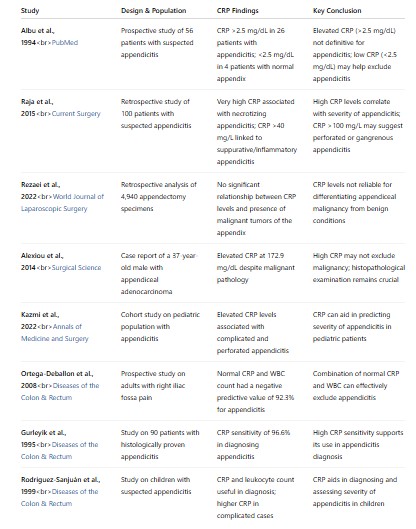Sunday Poster Session
Category: Colorectal Cancer Prevention
P0520 - Discriminatory Value of C-Reactive Protein in Differentiating Appendiceal Adenomucous Carcinoma from Acute Infectious Appendicitis: A Systematic Review and Meta-Analysis
Sunday, October 26, 2025
3:30 PM - 7:00 PM PDT
Location: Exhibit Hall
- FC
Faiza Chaudhary, MD
Jamaica Hospital Medical Center
Jamaica, NY
Presenting Author(s)
Faiza Chaudhary, MD, Aizaaz Khan, MD
Jamaica Hospital Medical Center, Jamaica, NY
Introduction: Adenomucous carcinoma of the appendix is an uncommon malignancy that often presents with signs indistinguishable from acute appendicitis. While imaging and clinical evaluation are the mainstays of diagnosis, they frequently fail to differentiate between inflammatory and malignant causes of right lower quadrant pain. C-reactive protein (CRP), an acute-phase reactant, is widely utilized to assess the severity of appendicitis. Its potential role in differentiating appendiceal neoplasms from acute appendicitis has been proposed, given the typically lower inflammatory response in malignancy. We conducted a meta-analysis to evaluate the discriminatory utility of CRP in distinguishing appendiceal adenomucous carcinoma from acute appendicitis.
Methods: A systematic review and meta-analysis were performed in accordance with PRISMA guidelines. Databases searched included PubMed, Embase, and Cochrane Library through May 2025. Studies included were observational cohorts or case-control studies that reported CRP values in both histologically confirmed appendiceal carcinoma and acute appendicitis. Data were extracted on mean or median CRP values, standard deviations or interquartile ranges, and diagnostic thresholds. Pooled standardized mean differences (SMD) and 95% confidence intervals (CI) were calculated using a random-effects model.
Results: Eight studies encompassing 4,912 patients (198 with appendiceal carcinoma and 4,714 with acute appendicitis) met inclusion criteria. The pooled CRP level was significantly lower in the carcinoma group (SMD −1.12; 95% CI −1.47 to −0.77; p < 0.001). Subgroup analysis of studies using a CRP cutoff < 30 mg/L demonstrated a sensitivity of 81% and specificity of 76% for detecting carcinoma in patients with right lower quadrant pain. Heterogeneity among studies was moderate (I² = 52%).
Discussion: This meta-analysis supports the hypothesis that lower CRP levels may help distinguish appendiceal adenomucous carcinoma from acute appendicitis. While CRP alone is not diagnostic, disproportionately low CRP in the setting of significant or chronic symptoms should raise suspicion for underlying malignancy. Incorporating CRP thresholds into clinical decision-making may enhance early detection of appendiceal neoplasms and improve preoperative planning. Further prospective studies are neeeded to discern the clinical validity.

Figure: Studies and case reports comparing levels of CRP in appendiceal infections versus malignancy and normal appendix
Disclosures:
Faiza Chaudhary indicated no relevant financial relationships.
Aizaaz Khan indicated no relevant financial relationships.
Faiza Chaudhary, MD, Aizaaz Khan, MD. P0520 - Discriminatory Value of C-Reactive Protein in Differentiating Appendiceal Adenomucous Carcinoma from Acute Infectious Appendicitis: A Systematic Review and Meta-Analysis, ACG 2025 Annual Scientific Meeting Abstracts. Phoenix, AZ: American College of Gastroenterology.
Jamaica Hospital Medical Center, Jamaica, NY
Introduction: Adenomucous carcinoma of the appendix is an uncommon malignancy that often presents with signs indistinguishable from acute appendicitis. While imaging and clinical evaluation are the mainstays of diagnosis, they frequently fail to differentiate between inflammatory and malignant causes of right lower quadrant pain. C-reactive protein (CRP), an acute-phase reactant, is widely utilized to assess the severity of appendicitis. Its potential role in differentiating appendiceal neoplasms from acute appendicitis has been proposed, given the typically lower inflammatory response in malignancy. We conducted a meta-analysis to evaluate the discriminatory utility of CRP in distinguishing appendiceal adenomucous carcinoma from acute appendicitis.
Methods: A systematic review and meta-analysis were performed in accordance with PRISMA guidelines. Databases searched included PubMed, Embase, and Cochrane Library through May 2025. Studies included were observational cohorts or case-control studies that reported CRP values in both histologically confirmed appendiceal carcinoma and acute appendicitis. Data were extracted on mean or median CRP values, standard deviations or interquartile ranges, and diagnostic thresholds. Pooled standardized mean differences (SMD) and 95% confidence intervals (CI) were calculated using a random-effects model.
Results: Eight studies encompassing 4,912 patients (198 with appendiceal carcinoma and 4,714 with acute appendicitis) met inclusion criteria. The pooled CRP level was significantly lower in the carcinoma group (SMD −1.12; 95% CI −1.47 to −0.77; p < 0.001). Subgroup analysis of studies using a CRP cutoff < 30 mg/L demonstrated a sensitivity of 81% and specificity of 76% for detecting carcinoma in patients with right lower quadrant pain. Heterogeneity among studies was moderate (I² = 52%).
Discussion: This meta-analysis supports the hypothesis that lower CRP levels may help distinguish appendiceal adenomucous carcinoma from acute appendicitis. While CRP alone is not diagnostic, disproportionately low CRP in the setting of significant or chronic symptoms should raise suspicion for underlying malignancy. Incorporating CRP thresholds into clinical decision-making may enhance early detection of appendiceal neoplasms and improve preoperative planning. Further prospective studies are neeeded to discern the clinical validity.

Figure: Studies and case reports comparing levels of CRP in appendiceal infections versus malignancy and normal appendix
Disclosures:
Faiza Chaudhary indicated no relevant financial relationships.
Aizaaz Khan indicated no relevant financial relationships.
Faiza Chaudhary, MD, Aizaaz Khan, MD. P0520 - Discriminatory Value of C-Reactive Protein in Differentiating Appendiceal Adenomucous Carcinoma from Acute Infectious Appendicitis: A Systematic Review and Meta-Analysis, ACG 2025 Annual Scientific Meeting Abstracts. Phoenix, AZ: American College of Gastroenterology.
